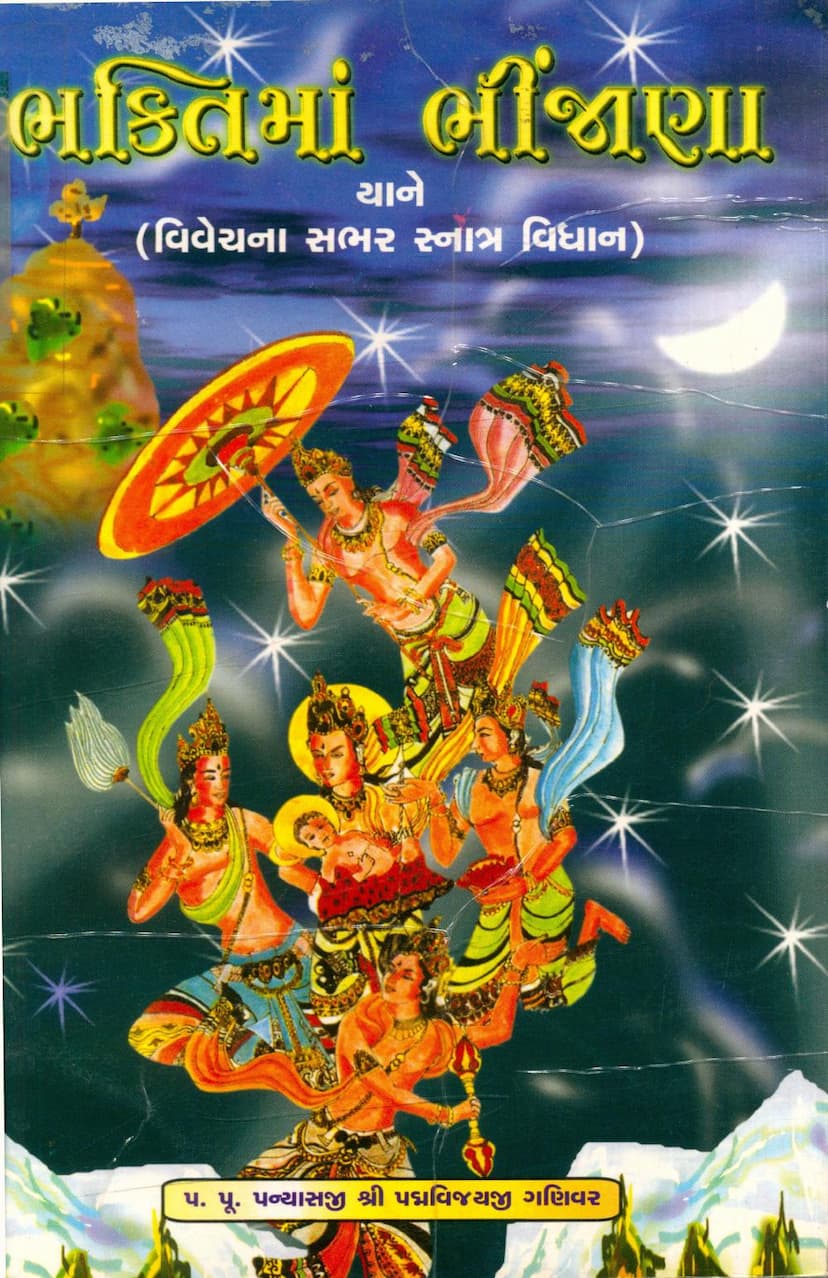Bhaktima Bhinjana
Added to library: September 1, 2025

Summary
Here's a comprehensive summary of the Jain text "Bhaktima Bhinjana" (which translates to "Immersed in Devotion"):
Title: Bhaktima Bhinjana (ભકિતમાં ભીંજીણા) Subtitle: Vivechana Sabar Snatra Vidhan (યાને વિવેચના સભર સ્નાત્ર વિધાન) - Meaning, A Bath Ritual (Snatra) Filled with Commentary/Analysis. Author: P.P. Nyas Pravar Shri Padmavijayji Ganivar (પ. પૂ. પન્યાસ પ્રવર શ્રી પદ્મવિજયજી ગણિવર્ય) Publisher: Sanghavi Ambalal Ratanchand Jain Dharmik Trust, Mumbai (સંઘવી અંબાલાલ રતનચંદ જૈન ધાર્મિક ટ્રસ્ટ, મુંબઇ) Sponsorship/Support: Several individuals and families are acknowledged for their generous contributions, as listed on pages 4 and 5. Dedication: The book is dedicated with deep reverence to the author's spiritual guides and mentors, including Acharya Dev Shrimad Vijayi Hemchandrasurishwarji Maharaj, Sadhvi Shri Vasantprabhaji Maharaj, Sadhvi Shri Swayamprabhaji Maharaj, and Sadhvi Shri Divyayshashriji Maharaj.
Core Content and Purpose:
"Bhaktima Bhinjana" is essentially a detailed commentary and explanation of a Snatra Vidhan (a ritualistic bath performed for Jain deities, particularly Tirthankaras during specific auspicious occasions like their birth). The book aims to deepen the devotee's understanding and emotional connection during this devotional practice.
Key Themes and Sections:
-
The Nature of Devotion (Bhakti):
- The text emphasizes that true devotion to the Divine (Paramatma/Jineshwar) is an unparalleled bliss, far exceeding worldly pleasures. It's an experience that is deeply personal and often beyond the capacity of words to fully describe, as illustrated by poetic verses.
- The author highlights that the Snatra ritual is a powerful means to experience this divine devotion.
-
The Purpose of Devotion and Rituals:
- The book argues that devotion and adherence to the teachings of the Tirthankaras are the primary means to overcome the cycle of birth and death (samsara) and attain liberation (moksha).
- The Snatra ritual, specifically, is presented as a way to purify the soul, earn merit (punya), reduce negative karma (karma nirjara), and achieve spiritual progress. It's a spiritual bath that cleanses the inner self rather than just the physical body.
-
The Significance of Snatra Ritual:
- The text elaborates on the origin and importance of the Snatra ritual, drawing parallels to the celestial celebration of a Tirthankara's birth on Mount Meru by the gods (Indras and celestials).
- It explains that the ritualistic bath is a representation of this grand celestial event, allowing human devotees to participate in that divine act of reverence.
- The Snatra ritual is described as a highly beneficial practice that requires minimal effort but yields immense spiritual rewards. It's presented as a way to express gratitude to the Tirthankaras for their immense kindness and guidance.
-
The Power of Divine Name and Form:
- The book extensively discusses the profound impact of chanting the names of the Tirthankaras and meditating on their divine form. It cites examples from Jain scriptures to illustrate how even the mere remembrance of the divine can lead to significant spiritual transformations.
- The text underscores the idea that the Tirthankara's image (pratima) is not just an idol but a representation of their virtues and purity, worthy of deep reverence and contemplation.
-
Cultivating Virtues and Eradicating Vices:
- A significant portion of the book is dedicated to explaining how devotion through rituals like Snatra helps in eradicating negative tendencies (kusanskar) like anger, greed, ego, and delusion, and cultivating positive virtues (susanskar) like compassion, forgiveness, detachment, and righteousness.
- The examples of Chanda Kaushik (the serpent) and Shalibhadra are used to illustrate the magnified effects of both negative and positive inclinations across lifetimes.
-
Detailed Breakdown of the Snatra Ritual:
- The book meticulously describes the steps involved in the Snatra ritual, from the initial preparations to the final prayers. This includes:
- Preparations: Offering flowers, removing previous day's offerings, preparing the divine image, and the significance of using pure and fragrant materials.
- The Bath (Abhisheka): The process of bathing the deity with pure water, Panchamrit (five ambrosial substances), and various fragrant liquids, emphasizing the need for reverence and proper procedure.
- Offerings: The significance of offering flowers (kusumanjali), incense (dhupa), lamps (deepa), and other items, with detailed explanations of their symbolic meaning and benefits.
- Worship and Chanting: The importance of reciting prayers, hymns, and the Namaskar Mahamantra.
- Devotional Arts: The role of music, dance, and instrumental performances in expressing devotion.
- Celestial Parallels: Descriptions of how gods and celestial beings perform similar rituals, emphasizing the grandeur and spiritual significance.
- The Tirthankara's Birth: The narrative of a Tirthankara's birth, the auspicious dreams of the mother, the celestial celebrations, and the impact of their advent on the universe.
- The Role of the Devotee: The book guides the reader on how to perform the ritual with the correct inner attitude (bhava), focus, and reverence, treating it as a personal communion with the Divine.
- The book meticulously describes the steps involved in the Snatra ritual, from the initial preparations to the final prayers. This includes:
-
Explanations of Specific Verses:
- The author provides detailed commentary on the verses and poems composed for the Snatra ritual, explaining their meaning, context, and spiritual implications. This includes interpretations of the verses by Pandit Veer Vijayji Maharaj, who composed the original Snatra verses.
-
The Author's Perspective:
- The author, Padmavijayji Ganivar, was known for his profound scholarship and strong spiritual discipline, even while battling a serious illness. He explains that this commentary was written at the inspiration of his Gurudev, Acharya Shrimad Vijay Premsoorishwarji Maharaj, to make the complex ritual accessible and meaningful to devotees.
Overall Message:
"Bhaktima Bhinjana" serves as a spiritual guide, aiming to transform a ritualistic act into a deeply devotional experience. It encourages followers to engage with the Snatra not merely as an outward ceremony but as an internal purification and a powerful pathway to spiritual growth and liberation, ultimately leading to the highest state of bliss and union with the divine. The book emphasizes that sincere devotion, understanding, and proper practice are key to unlocking the profound benefits of these Jain rituals.